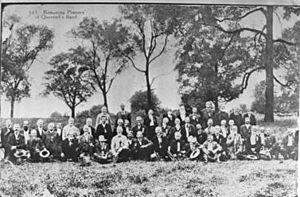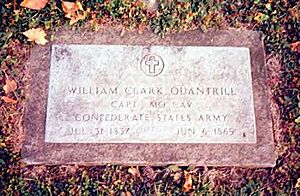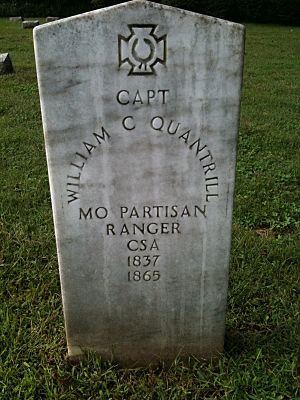William Quantrill facts for kids
Quick facts for kids
William Quantrill
|
|
|---|---|
 |
|
| Birth name | William Clarke Quantrill |
| Born | July 31, 1837 Canal Dover (now Dover), Ohio |
| Died | June 6, 1865 (aged 27) Louisville, Kentucky |
| Buried |
St. John's Catholic Cemetery
Louisville, Kentucky |
| Allegiance | |
| Service/ |
Confederate States Army Quantrill's Raiders |
| Years of service | 1861–1865 |
| Battles/wars | |
William Clarke Quantrill (born July 31, 1837 – died June 6, 1865) was a leader of a Confederate group during the American Civil War. This group used special fighting methods called guerrilla tactics.
Quantrill started as a schoolteacher. Later, he joined a group that became known as "Quantrill's Raiders". This group supported the Confederacy. They were known for their tough fighting style. Famous outlaws like Jesse James and his brother Frank James were part of this group.
Many later outlaws and bandits of the Old West were influenced by Quantrill. In May 1865, near the end of the Civil War, Quantrill was badly hurt in a fight with Union soldiers in Kentucky. He died from his injuries in June.
Contents
Early Life and Changes
William Quantrill was born in Canal Dover, Ohio, on July 31, 1837. He was the oldest of twelve children. By age sixteen, he was already teaching school in Ohio.
In 1854, his father died, leaving the family with money problems. William's mother had to rent out rooms in their home to make a living. William helped by continuing to teach. A year later, he left home and went to Mendota, Illinois, where he worked in lumberyards.
Quantrill kept teaching, moving to Fort Wayne, Indiana, in 1856. He returned home that fall. He soon felt restless in his small hometown. Many people from Ohio were moving to Kansas Territory for cheap land. William joined two men, Henry Torrey and Harmon Beeson, hoping to start a new life.
They settled near Marais des Cygnes in Kansas. However, they had a disagreement about land, and Quantrill ended up in court. He paid only half of what he owed. He stayed friends with Torrey, but his relationship with Beeson changed.
Later, Quantrill joined friends trying to start a new community. But neighbors noticed him stealing things. In January 1858, he was asked to leave the community. He then worked as a teamster for the U.S. Army, traveling to Salt Lake City, Utah. He was good at poker but lost all his winnings one day.
Quantrill then became a drifter, joining a group that protected Missouri farmers from Jayhawkers (pro-Union fighters). He traveled to Utah and Colorado before returning to Lawrence, Kansas, in 1859. He taught school there until 1860. After that, he started stealing cattle and capturing runaway slaves for money.
At first, before 1860, Quantrill seemed to be against slavery. He wrote letters saying that certain anti-slavery leaders were good people. But by February 1860, his views changed. He wrote to his mother that he now believed slavery was right. He also said he disliked anti-slavery leaders.
Becoming a Guerrilla Leader
In 1861, Quantrill went to Texas. There, he met Joel B. Mayes, a Cherokee leader who supported the Confederacy. Mayes taught Quantrill about guerrilla warfare tactics. These included ambush fighting, using camouflage, and surprise attacks.
Quantrill, along with Mayes and the Cherokee Nations, joined General Sterling Price. They fought in battles like the Battle of Wilson's Creek and Lexington in 1861.
In late September 1861, Quantrill left General Price's army. He went to Blue Springs, Missouri, to create his own group of loyal men. These men believed in him and the Confederate cause. They became known as "Quantrill's Raiders".
By Christmas 1861, he had ten full-time followers. Later in 1862, more men joined, including Cole Younger, William T. "Bloody Bill" Anderson, and the James brothers.
Quantrill and his men carried out several attacks:
- On March 7, 1862, they took over a Union outpost in Aubry, Kansas, and robbed the town.
- On March 11, 1862, Quantrill joined other Confederate forces to attack Independence, Missouri. After this, the Confederate government officially made him a captain.
- On September 7, 1862, Quantrill and 140 of his men captured Olathe, Kansas. They surprised 125 Union soldiers, who had to surrender.
- On October 5, 1862, Quantrill attacked and destroyed Shawneetown, Kansas.
- On November 5, 1862, Quantrill tried to attack Lamar, Missouri. But Union soldiers were ready and pushed back the raiders. Quantrill's men burned part of the town before leaving.
The Lawrence Massacre
The most well-known event involving Quantrill happened on August 21, 1863. The town of Lawrence, Kansas, was seen as a strong center for anti-slavery groups. It was also a base for pro-Union forces who raided Missouri.
Before the raid, Union General Thomas Ewing Jr. had ordered that anyone helping Quantrill's Raiders be arrested. Some female relatives of the guerrillas were held in a jail in Kansas City, Missouri. On August 14, the building collapsed. Four young women died, and others were badly hurt. One of the dead was the sister of Bill Anderson, a key ally of Quantrill. Quantrill's men believed the collapse was on purpose, which made them very angry.
Some historians think Quantrill had already planned to attack Lawrence. This was to get back at earlier raids by Jayhawkers and the burning of Osceola, Missouri.
Early on August 21, Quantrill and about 450 guerrilla fighters attacked Lawrence. They killed around 150 men and boys. When Quantrill's men left at 9 a.m., most of Lawrence's buildings were burning.
In response to the raid, General Ewing issued General Order No. 11 on August 25. This order forced thousands of civilians to leave their homes in three and a half Missouri counties along the Kansas border. Union troops then burned buildings, fields, and killed livestock. This was to stop the guerrillas from getting food and support. This area became known as the "Burnt District" because of the destruction.
In early October, Quantrill and his men went south to Texas for the winter. On their way, on October 6, Quantrill attacked Fort Blair in Baxter Springs, Kansas. After being pushed back, Quantrill surprised and defeated a Union group led by General James G. Blunt. Almost 100 Union soldiers were killed.
Last Years and Death
While in Texas, Quantrill and his 400 men had disagreements. His large group split into smaller ones. Quantrill briefly joined a group led by his lieutenant, "Bloody Bill" Anderson, in late 1864.
In the spring of 1865, Quantrill led a smaller group of pro-Confederates on raids in western Kentucky. Confederate General Robert E. Lee surrendered on April 9. Most of the Confederate Army surrendered by April 26.
On May 10, Quantrill and his group were caught in a Union ambush at Wakefield Farm. He was shot in the back and became paralyzed. He was taken to a military prison hospital in Louisville, Kentucky. William Quantrill died from his wounds on June 6, 1865, at age 27.
Burial

Quantrill was buried in an unmarked grave in what is now St. John's Cemetery in Louisville. Later, a friend claimed to have dug up Quantrill's remains in 1887. He said he brought them back to Dover, Ohio, for Quantrill's mother. These remains were supposedly buried in Dover in 1889. However, the friend tried to sell what he said were Quantrill's bones, so it's not certain if they were real.
In the early 1990s, some bones and hair, believed to be Quantrill's, were re-buried in 1992 at the Old Confederate Veteran's Home Cemetery in Higginsville, Missouri. Because of this, there are grave markers for Quantrill in Louisville, Dover, and Higginsville.
In Popular Culture
Quantrill and his Raiders have appeared in many stories, movies, and TV shows.
Movies
- Dark Command (1940) shows a character named "William Cantrell" who is based on Quantrill.
- Kansas Raiders (1950) shows Brian Donlevy as Quantrill and Audie Murphy as a young Jesse James.
- Quantrill's Raiders (1958) focuses on the raid on Lawrence.
- The Outlaw Josey Wales (1976) mentions Quantrill and his group.
- Ride with the Devil (1999) shows the Lawrence Massacre and features Quantrill.
Books
- Wildwood Boys (2000) is a book about "Bloody Bill" Anderson, who was one of Quantrill's men.
- The Rebel Outlaw: Josey Wales (later called Gone to Texas) is a book about Josey Wales, who rode with "Bloody Bill" Anderson. This book was made into a movie.
- In the story "The Territory" (1992), a different history is imagined where Samuel Clemens joins Quantrill's Raiders.
Music
- Woody Guthrie's song "Belle Starr" mentions Quantrill as one of Belle Starr's lovers.
Television
- The TV show Gunsmoke had an episode where a character was one of Quantrill's Raiders.
- Into the West (2005), a mini-series by Steven Spielberg, shows Quantrill's Lawrence Massacre.
See also
 In Spanish: William Quantrill para niños
In Spanish: William Quantrill para niños



